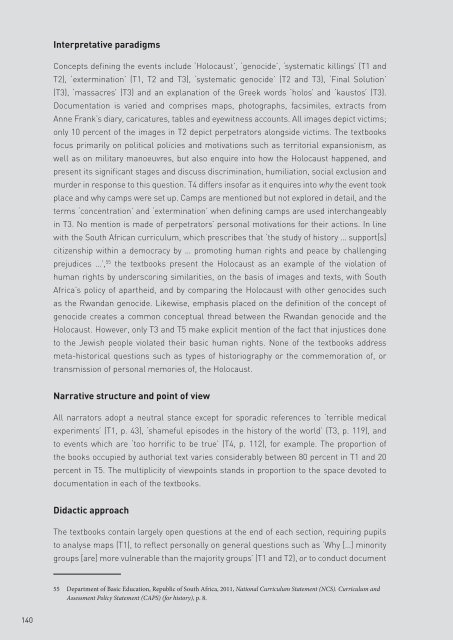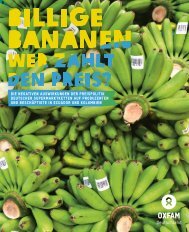228776e
228776e
228776e
You also want an ePaper? Increase the reach of your titles
YUMPU automatically turns print PDFs into web optimized ePapers that Google loves.
Interpretative paradigms<br />
Concepts defining the events include ‘Holocaust’, ‘genocide’, ‘systematic killings’ (T1 and<br />
T2), ‘extermination’ (T1, T2 and T3), ‘systematic genocide’ (T2 and T3), ‘Final Solution’<br />
(T3), ‘massacres’ (T3) and an explanation of the Greek words ‘holos’ and ‘kaustos’ (T3).<br />
Documentation is varied and comprises maps, photographs, facsimiles, extracts from<br />
Anne Frank’s diary, caricatures, tables and eyewitness accounts. All images depict victims;<br />
only 10 percent of the images in T2 depict perpetrators alongside victims. The textbooks<br />
focus primarily on political policies and motivations such as territorial expansionism, as<br />
well as on military manoeuvres, but also enquire into how the Holocaust happened, and<br />
present its significant stages and discuss discrimination, humiliation, social exclusion and<br />
murder in response to this question. T4 differs insofar as it enquires into why the event took<br />
place and why camps were set up. Camps are mentioned but not explored in detail, and the<br />
terms ‘concentration’ and ‘extermination’ when defining camps are used interchangeably<br />
in T3. No mention is made of perpetrators’ personal motivations for their actions. In line<br />
with the South African curriculum, which prescribes that ‘the study of history … support[s]<br />
citizenship within a democracy by … promoting human rights and peace by challenging<br />
prejudices …’, 55 the textbooks present the Holocaust as an example of the violation of<br />
human rights by underscoring similarities, on the basis of images and texts, with South<br />
Africa’s policy of apartheid, and by comparing the Holocaust with other genocides such<br />
as the Rwandan genocide. Likewise, emphasis placed on the definition of the concept of<br />
genocide creates a common conceptual thread between the Rwandan genocide and the<br />
Holocaust. However, only T3 and T5 make explicit mention of the fact that injustices done<br />
to the Jewish people violated their basic human rights. None of the textbooks address<br />
meta-historical questions such as types of historiography or the commemoration of, or<br />
transmission of personal memories of, the Holocaust.<br />
Narrative structure and point of view<br />
All narrators adopt a neutral stance except for sporadic references to ‘terrible medical<br />
experiments’ (T1, p. 43), ‘shameful episodes in the history of the world’ (T3, p. 119), and<br />
to events which are ‘too horrific to be true’ (T4, p. 112), for example. The proportion of<br />
the books occupied by authorial text varies considerably between 80 percent in T1 and 20<br />
percent in T5. The multiplicity of viewpoints stands in proportion to the space devoted to<br />
documentation in each of the textbooks.<br />
Didactic approach<br />
The textbooks contain largely open questions at the end of each section, requiring pupils<br />
to analyse maps (T1), to reflect personally on general questions such as ‘Why […] minority<br />
groups [are] more vulnerable than the majority groups’ (T1 and T2), or to conduct document<br />
55 Department of Basic Education, Republic of South Africa, 2011, National Curriculum Statement (NCS). Curriculum and<br />
Assessment Policy Statement (CAPS) (for history), p. 8.<br />
140




